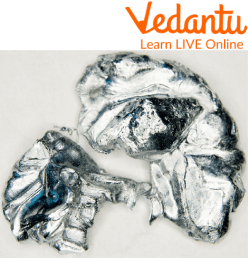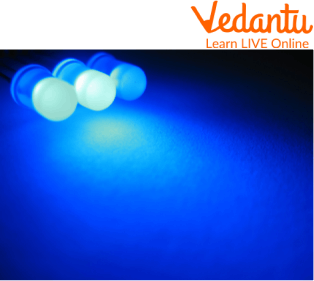




Overview of Gallium
The periodic table is a system for grouping chemical elements. All matter is composed of fundamental components known as chemical elements. Every chemical element has a unique property known as an element's atomic number. Each atom of the element contains a certain number of protons, which are tiny particles. The elements are arranged in rows and columns on the periodic table according to their atomic number and chemical properties, respectively.

Crystals of Gallium Joined Together
Today we will study an element which has some unusual properties. If I place that element in your hand, it will melt. Can you guess the name of such an element? The element is Gallium. Gallium is derived from the Latin word Gallia, meaning ‘Gaul’. Lecoq de Boisbaudran was the one who discovered gallium in 1875.
In this article, we will learn about this element and its many properties. The uses and characteristics of gallium are also discussed in this article. So, without wasting time, let’s dive in!

Gallium Melting in Hands
Gallium in the Periodic Table
Gallium is classified in group 13 as the third element in the periodic table. It is categorised as "other" metal or post-transition metal. An atom of gallium has 31 protons, 31 electrons, and 3 valence electrons in the outer shell. Further, we will learn about gallium's melting point, boiling point of gallium, uses of gallium, and interesting facts about gallium.
Characteristics and Properties of Gallium
The characteristics and properties of Gallium are as follows:
Gallium Symbol: Ga
Gallium Atomic Number: 31
Atomic Weight: 69.723
Classification: Post-transition or "other" metal
Phase at Room Temperature: Solid
Density: 5.91 grams per cm cubed
Melting Point: 29.76°C or 85.57°F
Boiling Point: 2204°C or 3999°F
Isotopes: Gallium-69 and Gallium-71
Gallium is a soft and brittle metal which can be broken easily, like glass. It is shiny and silvery. The low melting and high boiling points of gallium are among its interesting characteristics. Because of its high melting point, it is solid at normal temperatures but melts in your hand.
Gallium expands by 3.1 per cent upon freezing or solidifies (like water freezes into ice). Due to the expansion that occurs as the temperature drops, you must be careful when keeping liquid gallium. It should not be stored in either glass or metal containers. A relatively reactive element, gallium interacts easily with both acids and alkalis. Usually, it is found in a +3 oxidation state.

Gallium-based Blue LEDs
Gallium is a semiconductor as it does not conduct electricity; therefore, it is used in computers to make them work. It is not found in its elemental form on earth, but it is produced as a byproduct of mining other metals, including aluminium and zinc.
Uses of Gallium
The uses of gallium are as follows
Gallium is used in some high-temperature thermometers.
Gallium can create brilliant mirrors as it wets glass and porcelain.
Gallium is commonly used to dope semiconductors and create solid-state electronics like transistors.
A liquid gallium-tin alloy could replace water-based computer chip cooling.
In medical imaging, gallium salts are used as radiocontrast materials.
Interesting Facts about Gallium
Some interesting facts about Gallium are listed below:
The Neutrino Observatory in Italy uses a lot of gallium to research the solar neutrinos created inside the Sun.
It is not used by either plants or animals and is thought to be non-toxic.
Laser diodes, which generate light from electricity, are made from gallium arsenide. For long-distance data transmission, this is preferred over fibre optics.
Bright blue LEDs are made from gallium.
Solar panels made of gallium are used to power space applications such as satellites and Mars rover missions.
The abundance of gallium in the crust of the Earth is 19 parts per million, making it the 34th most prevalent element there.
During World War II, gallium was initially acknowledged as a crucial mineral resource and used in the core of the first atomic weapon to assist stabilise the crystal structure of plutonium in an alloy created as part of the Manhattan Project.
Summary
Element Gallium is derived from the Latin word Gallia meaning 'Gaul'. An atom of gallium has 31 protons, 31 electrons, and 3 valence electrons in the outer shell. The melting point and boiling point of gallium are 29.76°C, 85.57°F and 2204°C, 3999°F respectively. With a weight abundance of 40 parts per billion, gallium is abundant in our solar system.
It is commonly employed in the production of solid-state electronics, including transistors and semiconductor doping. Solar panels of gallium are used to power space applications such as satellites and Mars rovers.
FAQs on Classification of Gallium and Its Properties
1. Who is the largest producer of gallium?
China generated 96% of the world's capacity for low-purity primary gallium, which comprised 83% of the total. The remaining production was produced in Japan, the Republic of Korea, Russia, and Ukraine.
2. Is gallium poisonous or hazardous?
At room temperature, gallium is a silvery-white liquid. Consuming this substance might be harmful. Aluminium gets corroded by it. Gallium can release poisonous gases at high temperatures that combine with water to generate a corrosive alkaline solution.
3. Why does gallium melt so easily?
The structure of gallium is unusual. A distance of 2.43 Å separates each atom from its nearest neighbour. Instead of being metallic, this extraordinary structure resembles isolated diatomic molecules. This explains why gallium has a melting point of only 30 °C, which is extremely low.









